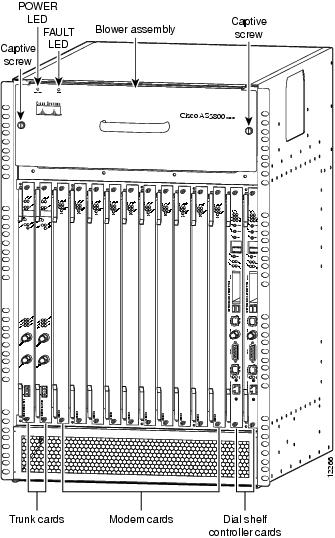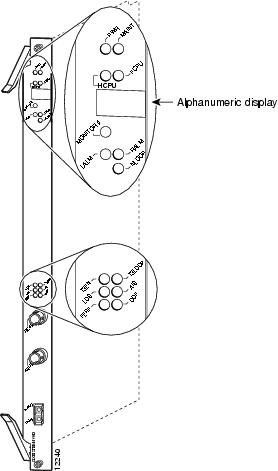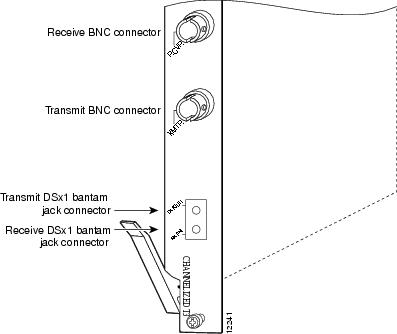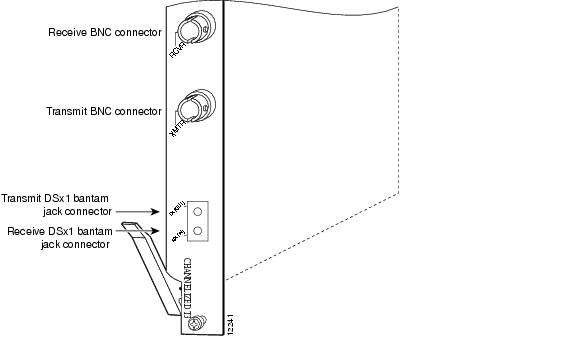

Table Of Contents
LED and Alphanumeric Indicators
Verifying and Troubleshooting the Installation
Configuring the CT1/CE1 Trunk Card
Channelized T3 Trunk Card
The Cisco AS5800 universal access server supports a channelized T3 (CT3) ingress interface that provides asynchronous aggregation of channelized interfaces and multiplexing on a single T3 facility. The CT1/CE1 trunk card is installed in the Cisco 5814 dial shelf chassis in slots 0 to slot 5. The Cisco AS5800 currently supports as many as two CT1/CE1 trunk cards.
This chapter explains how to remove and replace a CT1/CE1 trunk card in the Cisco 5814 dial shelf chassis, and also includes steps for verifying and troubleshooting your trunk card installation and configuring your software.
CT1/CE1 Trunk Card Overview
The CT1/CE1 trunk card contains an onboard M13 multiplexer, which multiplexes 28 separate T1 lines into a single T3 line. Each CT1/CE1 trunk card installed in the Cisco 5814 dial shelf contains all necessary functionality to terminate link signaling and incoming digital calls.
Figure 3-1 shows the CT1/CE1 trunk card.
Figure 3-1 CT1/CE1 Trunk Card
Each CT1/CE1 trunk card performs the following functions:
•
Provides physical termination for as many as 672 sessions.
•
Provides digital termination for as many as 256 DS0 connections (calls) using onboard High-Level Data Link Control (HDLC) controllers. Note that the D-channel of a PRI consumes a single channel of an HDLC controller.
•
Removes framing and embedded signaling bits (or inserts them, depending on the direction of the flow), demultiplexing the calls. The framer CPU sends the data stream to onboard time-division multiplexing (TDM) resources, which break out each call and pass each call to an appropriate call termination resource. Digital or ISDN-originated calls are terminated onboard the CT1/CE1 trunk card on HDLC controllers.
Note
Each D-channel consumes an HDLC controller.
Analog modem-originated calls are passed over the dial shelf backplane TDM bus to an available modem resource. The system software controls modem and HDLC resource management.
•
Responds to time-sensitive signaling. Each CT1/CE1 trunk card can supply two clocks from any two of its 28 ports. You can assign priorities to these clocks or accept the default values assigned by the software.
•
Processes counting information for performance monitoring.
•
Supports online insertion and removal (OIR), a feature that allows you to remove and replace a trunk card in the Cisco 5814 dial shelf while the system is operating without disrupting other cards and their associated calls. If you remove a trunk card while the system is operating, all calls associated with the CT3 lines on that card are dropped. Calls being handled by other trunk or modem cards, however, are not affected. For more information, see the "Online Insertion and Removal" section.
Figure 3-2 shows two trunk cards installed in a fully-configured Cisco 5814 dial shelf chassis.
Figure 3-2 Cisco 5814 Dial Shelf Chassis Fully Configured with Trunk Cards Installed
Clocking
All Cisco AS5800 access server trunk cards use the same transmit clock. This clock can originate from the following sources:
•
TDM clock source—A priority value from 1 to 50 that is applied to a clock source when multiple clock sources are used
•
External clock source—A clock source external to the access server
Clocks are prioritized by slot number (slots 0 to 5). The highest-priority clock is selected from the card in slot 0 and used as the default clock. If this clock fails, the highest-priority clock from the card in slot 1 becomes the default clock, and so forth.
The trunk card then forwards the clocks to the dial shelf controller. The dial shelf controller selects the highest-priority clock as the system primary clock, and the rest of the clocks remain in a prioritized backup queue.
Instead of using the default algorithm for clock selection, you can specify clocks through global configuration and select a maximum of two clocks per trunk card.
If you configure fewer than two clocks on a trunk card and all other configured clocks fail, clock selection resorts to the default algorithm on that card and the second clock will be selected automatically.
CT3 Clocking
CT1/CE1 trunk cards are usually attached to an external device, such as a Digital Access and Crossconnect System (DACS) or Add-Drop Multiplexer (ADM). This point-to-point link requires a single clock source to which the CT3 link is timed. You must determine whether you want the CT1/CE1 trunk card or an external device to be used as the primary clock source and configure it accordingly during the software configuration process, which is discussed in the "Configuration Commands" section.
CT1 Clocking
The CT1/CE1 trunk card has 28 T1 framers that always get their clock from the line. As a result, configuration of T1 clock sources is not allowed.
LED and Alphanumeric Indicators
The CT1/CE1 trunk card front panel is designed with LED and alphanumeric displays to provide trunk card status. (See Figure 3-3.)
Figure 3-3 CT1/CE1 Trunk Card Front Panel LED and Alphanumeric Indicators
Table 3-1 lists the CT1/CE1 trunk card LEDs and their functions.
Table 3-1 CT1/CE1 Trunk Card LED Indicators
PWR
Green
Power—Lights when power is ON.
MAINT
Yellow
Maintenance—Lights to indicate that the feature card is ready for OIR.
HCPU
Green
Host CPU—Lights when the associated host CPU is determined to be in good working condition; shuts off when there is an error condition or code is being downloaded.
FCPU
Green
Framing data link—Lights when the associated FDL CPU is determined to be in good working condition; shuts off when there is an error condition or code is being downloaded.
LALM
Yellow
Local alarm—Lights to indicate a T1 alarm condition was encountered by software for a particular port; remains OFF when the operating condition is normal.
RALM
Yellow
Remote alarm—Lights to indicate a T1 alarm condition was encountered by software for a particular port; remains OFF when the operating condition is normal.
NLOOP
Yellow
Network loop—Lights to indicate that at least one T1 is unavailable (status indicator); remains OFF when the operating condition is normal.
T3EN
Green1
Enable—Lights to indicate a CT3 card line connection enabling normal operation.
T3LOOP2
Yellow3
Loopback—Lights to indicate that a loopback condition exists on the CT3 line; software controlled.
LOS
Yellow3
Loss-of-signal—Lights to indicate that the CT3 framer is experiencing a loss of signal (175 successive zeros).
AIS
Yellow3
Alarm indication signal—Lights to indicate the presence of AIS in the received CT3 line. Lights to indicate that a T3 alarm condition exists; remains OFF when the operating condition is normal.
FERF
Yellow3
Far-end receive failure—Lights to indicate a far-end receive failure on the CT3 line.
OOF
Yellow3
Out-of-frame—Lights to indicate an out-of-frame condition on the CT3 line.
1 This LED must be lit for proper CT3 operation.
2 When in loopback mode, enables diagnostics to perform local CT3 testing without external support. The CT3 line is not affected by this condition, thus remaining disconnected and open.
3 This LED must remain off for proper CT3 operation.
Trunk Card Connectors
The CT3 front panel is designed with two types of cable connectors (see Figure 3-4). The BNC connectors are used to connect the cables carrying the T3 signals. The bantam jacks are used for local BERT circuit testing to the DS1 level.
Figure 3-4 CT1/CE1 Trunk Card Front Panel Connectors
Cables
The CT1/CE1 trunk card receives and transmits 45 Mbps signals through a 75-ohm cable, using common BNC coaxial cable connectors (see Figure 3-5). There are two female BNC connectors: one for T3 transmit data and one for T3 receive data.
Figure 3-5 CT3 75-Ohm Coaxial Cable
Using the Test Port
The CT3 trunk card front panel is designed with an alphanumeric display to provide trunk card status and port monitoring information (see Figure 3-3).
Test-port functionality is supported by Cisco IOS Release 12.0(6)T and later releases.
Trunk Card Bantam Jacks
The test port is a set of bantam jack connectors located at the bottom of the CT3 front panel (see Figure 3-4). The bantam jacks allow the connection of an external test device (for example, a FIREBERD test device) to test any of the 28 individual T1 circuits in drop-and-insert mode or to monitor an individual T1 circuit in monitor mode.
•
In drop-and-insert mode, the T1 line is dropped out of service. To prevent accidental use of the push button in drop-and-insert mode, use the test trunk drop-insert privileged EXEC command to disable the drop-and-insert mode on the specified T3 controller.
•
In monitor mode, you can monitor only the ingress side of the T1 line. The T1 line being monitored is not disrupted, and the line maintains its HDLC and modem connections through TDM.
Drop-and-Insert Mode
The test trunk drop-insert privileged EXEC command is used to enable or disable drop-and-insert mode on a T3 controller. When the system initially boots up, the drop-and-insert mode is disabled on all T3 controllers.
To drop a particular T1 line to the test port, follow these steps:
Step 1
Enable drop-and-insert mode by entering the test trunk drop-insert on privileged EXEC command as follows:
AS5800# test trunk drop-insert on shelf/slot/unit
Note
The shelf/slot/unit identifies the T1 to the CT3 controller.
Step 2
Push and quickly release the push button below the LED to toggle to the port number. The push button is labeled "MONITOR #" in Figure 3-3.
Note
You must release the push button within 2 seconds to advance through the port numbers (from 1 to 28). After port 28, the display returns to port 1.
Step 3
Push and hold the push button for two or more seconds.
The letter "D" (indicating drop-insert) is displayed in the front panel LED, indicating that the particular T1 line has been dropped to the test port.
Note
To select another port number, press the push button again and hold it for two or more seconds. You can now toggle to another port number.
Step 4
Disable the drop-and-insert mode after testing the T1 lines. We recommend that you disable drop-and-insert mode to prevent accidental use of the push button on the CT3 board.
To disable drop-and-insert mode, enter the test trunk drop-insert off privileged EXEC command as follows:
AS5800# test trunk drop-insert off shelf/slot/unit
Monitor Mode
To monitor a particular T1 line at the test port, follow these steps:
Step 1
Verify that drop-and-insert mode is disabled on the CT3 controller by entering the show command, as follows:
AS5800# sh controller t3 shelf/slot/unitThe following is sample output from the sh controller t3 command if drop-and-insert mode is disabled:
AS5800# show controller t3 1/1/0T3 1/1/0 is up.Applique type is Channelized T3No alarms detected.FEAC code received: No code is being receivedFraming is M23, Line Code B3ZS, Clock Source is InternalDrop-insert is disabledData in current interval (90 seconds elapsed):0 Line Code Violations, 0 P-bit Coding Violation0 C-bit Coding Violation, 0 P-bit Err Secs0 P-bit Severely Err Secs, 0 Severely Err Framing Secs0 Unavailable Secs, 0 Line Errored Secs0 C-bit Errored Secs, 0 C-bit Severely Errored SecsAS5800#
Note
If the display shows Drop-insert is enabled, repeat Step 4 in the "Drop-and-Insert Mode" section.
Step 2
Push and quickly release the push button below the LED to toggle to the port number. The push button is labeled "MONITOR #" in Figure 3-3.
Note
You must release the push button within two seconds to advance through the port numbers (from 1 to 28). After port 28, the display returns to port 1.
Step 3
Push and hold the push button for two or more seconds.
The letter "M" (indicating monitor) is shown in the front panel display, indicating that you can monitor the particular T1 line at the test port.
Note
To select another port number, press the push button again and hold it for two or more seconds. You can now toggle to another port number.
Specifications
Table 3-2 lists the CT1/CE1 trunk card specifications.
Table 3-2 CT1/CE1 Trunk Card Specifications
Dimensions H x W x L
15.4 x 0.08 x 18.7 in. (39.12 x 0.203 x 47.5 cm) without the carrier
15.5 x 1.23 x 19 in. (39.37 x 3.12 x 48.26 cm) with the carrierWeight
8 lb (3.6 kg)
Transmission bit rate
44,736 Mbps
MTBF1
Exceeds 50,000 hr
Power requirements
+3.3 VDC, 8A, ±5%
+5.0 VDC, 15A, ± 5%Regulatory compliance
Safety: UL 1950, CSA 22.2 No. 950, EN60950, AUSTEL TS001, AS/NZS 3260, IEC 950
Emissions: CFR 47 Part 15 Class B(FCC), CISPR22 Class B, EN55022 Class B, AS/NRZ 3548 Class B, ICES003, VCCI Class B
Immunity: IEC 1000-3-2, IEC 1000-3-3, IEC-1000-4-2, IEC-1000-4-3, IEC-1000-4-4, IEC-1000-4-5, IEC-1000-4-6, IEC-1000-4-11, EN50082-1, EN50082-2
For additional compliance information, refer to the Regulatory Compliance and Safety Information document that accompanied this device.
1 MTBF = Mean time between failures.
Connecting Trunk Card Cables
The CT1/CE1 trunk card receives and transmits 45-Mbps signals through a 75-ohm cable, using common female BNC coaxial cable connectors. There are two female BNC connectors: one for T3 transmit data and one for T3 receive data. Use a 75-ohm coaxial cable to connect the T3 lines (see Figure 3-5).
To connect the T3 lines, follow these steps:
Step 1
Attach the end of the T3 cable directly to the BNC receptacle on the trunk card (see Figure 3-6).
Figure 3-6 CT1/CE1 Trunk Card BNC Cable Connections
Step 2
Attach the network end of your CT3 cable to your external network.
Configuring Cable Length
When you configure your CT1/CE1 trunk cards, you must include the length of the cable connected to the card. To specify this length, use the cablelength command and designate the length of the DS3 cable, as shown in Table 3-3. Cable length is a number of feet from 0 to 450.
When you configure your system for CT3 lines, you must also include additional commands to define framing, line code, clock source, signaling, and so forth. For additional software information, refer to the Cisco AS5800 Universal Access Server Operation, Administration, Maintenance, and Provisioning Guide that shipped with your system.
This completes the trunk card installation procedure. To verify the installation, proceed to the following section "Verifying and Troubleshooting the Installation."
Verifying and Troubleshooting the Installation
When you first power ON your Cisco AS5800, all LEDs light while the system runs a series of diagnostics. After the system passes initial diagnostics, all LEDs shut off. The LEDs then light again as described in Table 3-1.
To complete the hardware installation, verify that the trunk card LEDs operate properly by observing the following LED states:
•
The power LED is ON.
If the power LED remains OFF, verify that the card is seated properly.
If the power LED lights on other trunk cards in the dial shelf, try inserting the trunk card in a different slot. If none of the power LEDs lights, check your dial shelf power connections, power entry modules, and AC-input power supplies (if present).
•
The HCPU LED is ON.
If the HCPU LED is OFF but the power LED is ON, the software image might have failed to load onto the card. The dial shelf controller attempts to reload the software automatically. After a programmed number of attempts to reload the software image fails, the dial shelf controller powers OFF the trunk card and all LEDs are shut off.
If this happens, assume that the failure is due to defective hardware. Return the card to the factory for replacement. For information on how to contact Cisco, see the "Obtaining Documentation" section.
•
The FCPU LED is ON.
If the FCPU LED is OFF while the HCPU LED is ON, either the hardware is defective or the framer processor software has crashed. To determine if the failure is software related, wait while the auto-reload feature on the dial shelf controller card attempts to reload the software image. If the software fails to reload after the programmed number of times, assume that the failure is due to defective hardware. Return the card to the factory for replacement.
Tips
For further installation troubleshooting information, refer to the Cisco AS5800 Universal Access Server Hardware Installation Guide.
Configuring the CT1/CE1 Trunk Card
The Cisco 5814 dial shelf recognizes trunk cards only in dial shelf slots 0 to 5. Therefore, install trunk cards only in the first six slots.
If you are replacing a dial shelf card by installing a new dial shelf card of the same type in the same slot, the system software recognizes the new dial shelf card interfaces and brings them up automatically. No additional configuration is needed.
If you are installing a trunk card in a different slot than the trunk card you just removed, additional configuration is needed. Refer to the Cisco AS5800 Universal Access Server Operation, Administration, Maintenance, and Provisioning Guide that shipped with your system.
Configuration Commands
Table 3-3 lists commands to help you configure your CT3 card.
Note
The / symbol is used in commands to specify a physical location. Thus 1/0/0 on a T3 port tells you where you can plug something in to the dial shelf. The : symbol is used in commands to specify a TDM channel within a physical port.
Table 3-3 T3 Configuration Commands
Step 1
Enter the enable command.
Enter your password.
You are in privileged EXEC mode when the prompt changes to AS5800#.
Step 2
Enter global configuration mode by entering the configure terminal command. The example uses the terminal configuration option.
You are in global configuration mode when the prompt changes to AS5800(config)#.
Step 3
Enter interface loopback 0 to create interface loopback 0, which is the logical IP subnet containing all dial-in user addresses.
You are in interface mode when the prompt changes to AS5800(config-if)#.
Step 4
Set the normal data path back to its source (either local or network).
Step 5
Enable the interface using the no shutdown command.1
Step 6
Enter controller configuration mode to configure your T3 controller port. The only legal port value is 0.
Step 7
Enter an optional text description for the T3 controller.
Step 8
Enter the controller cablelength value, from 0 to 450 (feet).
Step 9
Enter the type of T3 framing used. C-bit specifies C-bit parity framing. M23 (default) specifies M23 multiplexer framing.
Step 10
Create a logical T1 controller from each of the specified T3 line time slots. The entry ds1 is a time slot within the T3 line with a value from 1 to 28.
Step 11
Enter controller configuration mode to configure your T3 controller port. T1-num is a T1 timeslot within the T3 line with a value from 1 to 28.
Step 12
Configure the clock source as an internal clock (internal) or a recovered clock (line).
Step 13
AS5800(config)# dial-tdm-clock priority {1-50} {external | trunk-slot} {0-5} ds3-port 0 port {1-28}Configure clock priority, which is a value from 1 to 50.
Select a clocking source by selecting an external reference clock or a trunk card. If you are using an external reference clock, no other CLI is needed. If you are using a trunk card, select a dial shelf slot from 0 to 5.
Select the T3 port number, which has a value of 0.
Step 14
Save your changes when ready.
1 To deactivate a command functionality, type no before the command.
To verify your software configuration, you can enter show commands to display clock (show dial-shelf clock) and controller (show controller t3) settings. To enter show commands, you must be in privileged EXEC mode. Some examples:
AS5800# show dial-shelf clockPrimary Clock:--------------Slot 12:System primary is 1/1/0:2 of priority 213TDM Bus Master Clock Generator State = NORMALBackup clocks:Source Slot Port DS3-Port Priority Status State-------------------------------------------------------------Trunk 0 1 0 206 Bad DefaultTrunk 0 2 0 212 Bad DefaultTrunk 1 4 0 225 Good DefaultStatus of trunk clocks:-----------------------Ds3 2 2 2 2 2 2 2 2 2 1 1 1 1 1 1 1 1 1 1Slot Port Type 8 7 6 5 4 3 2 1 0 9 8 7 6 5 4 3 2 1 0 9 8 7 6 5 4 3 2 10 0 T3 G G G G G G G G G G G G G G G G G G G G G G G G G G G G1 0 T3 B B B B B B B B B B B B B B B B B B B B G G G G G G G GAS5800# show controller t3T3 1/0/0 is up.Applique type is Channelized T3No alarms detected.FEAC code received: No code is being receivedFraming is M23, Line Code is B3ZS, Clock Source is Line.Data in current interval (751 seconds elapsed):0 Line Code Violations, 0 P-bit Coding Violation0 C-bit Coding Violation, 0 P-bit Err Secs0 P-bit Severely Err Secs, 0 Severely Err Framing Secs0 Unavailable Secs, 0 Line Errored Secs0 C-bit Errored Secs, 0 C-bit Severely Errored SecsTotal Data (last 16 15 minute intervals):34989 Line Code Violations, 16414 P-bit Coding Violation,49331 C-bit Coding Violation, 0 P-bit Err Secs,0 P-bit Severely Err Secs, 0 Severely Err Framing Secs,12 Unavailable Secs, 0 Line Errored Secs,10 C-bit Errored Secs, 10 C-bit Severely Errored SecsT3 1/1/0 is up.Applique type is Channelized T3No alarms detected.FEAC code received: No code is being receivedFraming is M23, Line Code is B3ZS, Clock Source is Line.Data in current interval (751 seconds elapsed):0 Line Code Violations, 0 P-bit Coding Violation0 C-bit Coding Violation, 0 P-bit Err Secs0 P-bit Severely Err Secs, 0 Severely Err Framing Secs0 Unavailable Secs, 0 Line Errored Secs0 C-bit Errored Secs, 0 C-bit Severely Errored SecsTotal Data (last 16 15 minute intervals):42579 Line Code Violations, 16421 P-bit Coding Violation,49208 C-bit Coding Violation, 0 P-bit Err Secs,0 P-bit Severely Err Secs, 0 Severely Err Framing Secs,2 Unavailable Secs, 0 Line Errored Secs,10 C-bit Errored Secs, 10 C-bit Severely Errored SecsA typical T3 controller configuration in a running-configuration file appears as follows:
T3 controller configuration:----------------------------controller T3 1/0/0framing m23clock source linecablelength 224t1 1 controllert1 2 controllert1 3 controllert1 4 controllert1 5 controllert1 6 controllert1 7 controllert1 8 controllert1 9 controllert1 10 controllert1 11 controllert1 12 controllert1 13 controllert1 14 controllert1 15 controllert1 16 controllert1 17 controllert1 18 controllert1 19 controllert1 20 controllert1 21 controllert1 22 controllert1 23 controllert1 24 controllert1 25 controllert1 26 controllert1 27 controllert1 28 controllerA typical T1 controller configuration appears as follows:
T1 controller configuration:----------------------------controller T1 1/0/0:1framing esfpri-group timeslots 1-24controller T1 1/0/0:2channel-group 0 timeslots 1-24...controller T1 1/1/0:28cas-group 0 timeslots 1-24

 Feedback
Feedback






